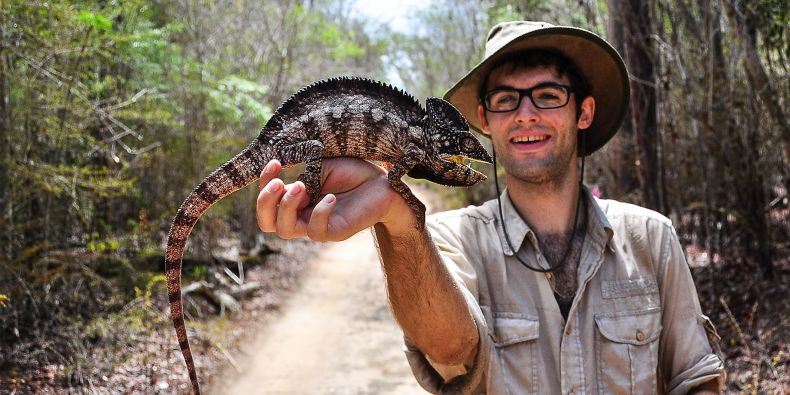At the end of the year zoology student Matej Dolinay went to places that most people know only from the films and photos of National Geographic, spending five weeks among plant and animal species that most textbooks never mention. In the national park of the Kirindy Forest in Madagascar he carried out field research under the aegis of the Tropical Biology Association, which is based at the University of Cambridge.
“For a zoologist with a special interest in evolution like me, this is probably the world's most amazing place," Dolinay explains with enthusiasm. “In no other place will you find so many species that live nowhere else."
The fact that a species is found only in this place is given by the development of the island as a whole. Originally it was part of the supercontinent Gondwana, which connected Africa, South America, India and Australia before it gradually disintegrated. Today's island of Madagascar became separate 88 million years ago.
“Many species reached this place on floating vegetation," explains Dolinay. “Since their arrival they have evolved separately. This is why 90 per cent of organisms here are not found anywhere else in the world."
Dolinay has been fascinated by animals since he was small, and not only those that live on this island off the coast of Africa. “I spouted on about dinosaurs from the age of about four," he explains.
For a long time, however, it seemed that he would not get to study the subject of his dreams. His family wanted him to become a professional tennis player, with animals as his hobby. (He kept snakes at home, and still does today.) After thoughts of a sports career were abandoned, Dolinay applied to study at the Faculty of Science. At last he was able to devote himself to the subject that had attracted him since childhood.
He has a keen interest in Africa, too. He has climbed Kilimanjaro, Africa's highest mountain. He had even been to Madagascar once before. So the decision to return to the island as a scientist was an easy one.
A long journey to the island
But how was he to get there? For Czech and Slovak schools, places such as Madagascar are hardly centres of scientific interest. He found the answer to his difficult question on the website of Britain's Tropical Biology Association, which organizes an annual expedition for enthusiastic university students from all over the world.

One awkward question was succeeded by others, however. Where should he get the money for the trip, and how was he to become one of eighteen chosen?
“It took me about a year," concedes Dolinay, who had to obtain references and, most importantly, money. In the end he was funded partly by a Rector's Scholarship and partly by a grant from the British Ecological Society; to this he added his own earnings and money donated by his parents.
He had a certain advantage over some of his fellows: he had an idea of what to expect from the journey and their destination. The two-day journey to the national park is anything but comfortable, and because of a lack of water in the area, those living in its wooden cottages are rationed to one bucket of water per day for washing.
No one minded conditions in the field, however – quite the opposite, in fact. At home everyone learns from books and scholarly articles; in the primeval forest of Africa, you learn from what you see with your own eyes.
“Everything happens in the field. In the first few days we conducted our studies on walks through the forest, followed by a pilot study," explains Dolinay. In this way he encountered a mouse lemur, the smallest primate species, which was discovered in Madagascar only in 2000, and a strange-looking cat-like creature called a fossa, which zoologists have long struggled to classify.
Living textbook
All the research performed by the international students and their teachers was concerned with protection of the environment. Like other poor areas of the world, Madagascar is battling intensive deforestation and devastation of nature.

“Today only about ten per cent of the original forest remains," says Dolinay. “It is destroyed by loggers but also by ordinary people, who burn some of it down each year. But as tropical earth is infertile, they soon go off in search of other places."
Dolinay and his fellows studied the peculiar way in which butterflies adapt to changed conditions. Loggers at work in the national park created a network of paths in the forest so that they could move their equipment about. According to Dolinay, the butterflies took these corridors as their own, using the same routes when migrating en masse.
Dolinay and a fellow student from Poland chose to observe and study predators that plunder bird's nests. Earlier research has indicated that bird's nests attract predators more often in areas where logging has taken place.
“We reached the same conclusion about the dry conditions of the tropical forest," says Dolinay. “A nest in a locality with a history of logging showed a rate of predation almost fifty per cent higher." Even such limited findings can help ecologists as they negotiate to increase protection in unique areas.
They will also help the students as they pursue a career in science. They are well aware of the possibility that their article will be published in a professional journal.
Dolinay hopes that it will not be the last such success. Not only would he like to go back to Madagascar, he and colleagues at the Academy of Sciences have applied for funding for a project that includes three trips to Sumatra, another exotic territory.
